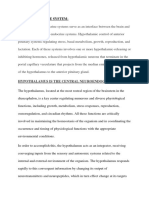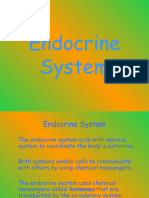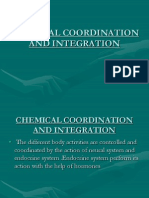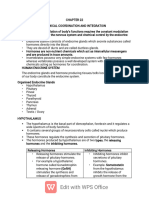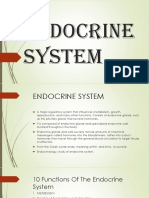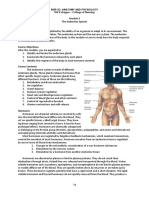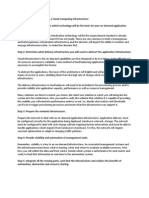0 ratings0% found this document useful (0 votes)
Endocrine Gland Nikhil
Endocrine Gland Nikhil
Uploaded by
nomnomnamrathaCopyright:
© All Rights Reserved
Available Formats
Download as PPTX, PDF, TXT or read online from Scribd
Download as pptx, pdf, or txt
Endocrine Gland Nikhil
Endocrine Gland Nikhil
Uploaded by
nomnomnamratha0 ratings0% found this document useful (0 votes)
Copyright
© © All Rights Reserved
Available Formats
PPTX, PDF, TXT or read online from Scribd
Share this document
Did you find this document useful?
Is this content inappropriate?
Copyright:
© All Rights Reserved
Available Formats
Download as PPTX, PDF, TXT or read online from Scribd
Download as pptx, pdf, or txt
0 ratings0% found this document useful (0 votes)
Endocrine Gland Nikhil
Endocrine Gland Nikhil
Uploaded by
nomnomnamrathaCopyright:
© All Rights Reserved
Available Formats
Download as PPTX, PDF, TXT or read online from Scribd
Download as pptx, pdf, or txt
You are on page 1/ 8
ENDOCRINE GLAND
Endocrine glands are ductless glands of
the endocrine system that secrete their
products, hormones, directly into the blood
. The major glands of the endocrine system
include the pineal gland, pituitary gland,
pancreas, ovaries, testicles, thyroid gland,
parathyroid gland, hypothalamus and
adrenal glands. The hypothalamus and
pituitary glands are neuroendocrine organs
.
HORMONES
• Local chemical messengers, not generally considered part of the endocrine system,
include autocrines, which act on the cells that secrete them, and paracrines, which act
on a different cell type nearby.
• The ability of a target cell to respond to a hormone depends on the presence of
receptors, within the cell or on its plasma membrane, to which the hormone can bind.
• Hormone receptors are dynamic structures. Changes in the number and sensitivity of
hormone receptors may occur in response to high or low levels of stimulating
hormones.
• Blood levels of hormones reflect a balance between secretion and degradation/
excretion. The liver and kidneys are the major organs that degrade hormones;
breakdown products are excreted in urine and faeces.
• Hormone half-life and duration of activity are limited and vary from hormone to
hormone.
PITUITARY GLAND AND
HYPOTHALAMUS
• The pituitary gland hangs from the base of the brain by the
pituitary stalk, and is enclosed by bone. It consists of a
hormone-producing glandular portion of the anterior pituitary
and a neural portion of the posterior pituitary, which is an
extension of the hypothalamus. The hypothalamus regulates
the hormonal output of the anterior pituitary and creates two
hormones that it exports to the posterior pituitary for storage
and later release. Somatotropic hormone or growth hormone
(GH) is an anabolic hormone that stimulates the growth of
all body tissues especially skeletal muscle and bone. It may
act directly, or indirectly via insulin-like growth factors (IGFs).
GH mobilizes fats, stimulates protein synthesis, and inhibits
glucose uptake and metabolism. Secretion is regulated by
growth hormone-releasing hormone (GHRH) and
growth hormone-inhibiting hormone (GHIH), or somatostatin.
Hypersecretion causes gigantism in children and acromegaly
in adults; hyposecretion in children causes
THYROID GLAND
• The thyroid gland is located in the front of the neck, in front of the
thyroid cartilage, and is shaped like a butterfly, with two wings
connected by a central isthmus. Thyroid tissue consists of follicles with
a stored protein called colloid, containing[thyroglobulin], a precursor to
other thyroid hormones, which are manufactured within the colloid.
• The thyroid hormones increase the rate of cellular metabolism, and
include thyroxine (T4) and triiodothyronine (T3). Secretion is
stimulated by the thyroid-stimulating hormone, secreted by the
anterior pituitary. When thyroid levels are high, there is negative
feedback that decreases the amount of Thyroid-stimulating hormone
secreted. Most T4 is converted to T3 (a more active form) in the target
tissues.
• Calcitonin, produced by the parafollicular cells (C cells) of the thyroid
gland in response to rising blood calcium levels, depresses blood
calcium levels by inhibiting bone matrix resorption and enhancing
calcium deposit in bones. Excessive secretion cause hyperthyroidism
and deficiency cause hypothyroidism.
ADRENAL GLANDS
• The adrenal glands are located above the
kidneys in humans and in front of the kidneys in
other animals. The adrenal glands produce a
variety of hormones including adrenaline and
the steroids aldosterone cortisol and
Dehydroepiandrosterone sulfate (DHEA).[3]
Adrenaline increases blood pressure, heart
rate, and metabolism in reaction to stress, the
aldosterone controls the body’s salt and water
balance , the cortisol plays a role in stress
response and the dehydroepiandrosterone
sulfate (DHEA) produces aids in production of
body odor and growth of body hair during
puberty.
PANCREAS
• The pancreas, located in the abdomen, below and
behind the stomach, is both an exocrine and an
endocrine gland. The alpha and beta cells are the
endocrine cells in the pancreatic islets that
release insulin and glucagon and smaller amounts
of other hormones into the blood. Insulin and
glucagon influence blood sugar levels. Glucagon
is released when the blood glucose level is low
and stimulates the liver to release glucose into
the blood. Insulin increases the rate of glucose
uptake and metabolism by most body cells.
• Somatostatin is released by delta cells and acts
as an inhibitor of GH, insulin, and glucagon
GONADS
• The ovaries of the female, located in the pelvic
cavity, release two main hormones. Secretion of
estrogens by the ovarian follicles begins at puberty
under the influence of follicle-stimulating hormone.
Estrogens stimulate the maturation of the female
reproductive system and the development of
secondary sexual characteristics. Progesterone is
released in response to high blood levels of
luteinizing hormone. It works with estrogens in
establishing the menstrual cycle.
• The testes of the male begin to produce
testosterone at puberty in response to luteinizing
hormone. Testosterone promotes maturation of the
male reproductive organs, development of
secondary sex characteristics such as increased
muscle and bone mass, and the growth of body hair.
BY NIKHIL
GRADEN 10
You might also like
- Skills For Science: Cambridge IGCSE Biology 0610 Chemistry 0620 Physics 0625No ratings yetSkills For Science: Cambridge IGCSE Biology 0610 Chemistry 0620 Physics 062540 pages
- C - EWM - 90 - SAP Certified Application Associate - Extended Warehouse Management 90% (1)C - EWM - 90 - SAP Certified Application Associate - Extended Warehouse Management 94 pages
- Self-Reflexivity and The Therapeutic Action of PsychoanalysisNo ratings yetSelf-Reflexivity and The Therapeutic Action of Psychoanalysis23 pages
- Chemical Coordination and Integration class 11 Notes BiologyNo ratings yetChemical Coordination and Integration class 11 Notes Biology7 pages
- Kunal-567) Glands and Hormones in Human Body - KunalNo ratings yetKunal-567) Glands and Hormones in Human Body - Kunal5 pages
- Revision Notes on Chemical Coordination and Integration for NEET 2024 - Free PDF DownloadNo ratings yetRevision Notes on Chemical Coordination and Integration for NEET 2024 - Free PDF Download7 pages
- CBSE Quick Revision Notes (Class-11 Biology) Chapter-22 Chemical Coordination and IntegrationNo ratings yetCBSE Quick Revision Notes (Class-11 Biology) Chapter-22 Chemical Coordination and Integration3 pages
- CBSE Quick Revision Notes (Class-11 Biology) Chapter-22 Chemical Coordination and IntegrationNo ratings yetCBSE Quick Revision Notes (Class-11 Biology) Chapter-22 Chemical Coordination and Integration3 pages
- Chemical Coordination and Integration Handwriten Notes For Neet and JeeNo ratings yetChemical Coordination and Integration Handwriten Notes For Neet and Jee5 pages
- Endocrine Gland: Aldrin Mercado Bsae Ii-ANo ratings yetEndocrine Gland: Aldrin Mercado Bsae Ii-A3 pages
- Endocrine Physiology Lecture by Mrs M MUTSANGU POLY ND1No ratings yetEndocrine Physiology Lecture by Mrs M MUTSANGU POLY ND156 pages
- Chemical Coordination and Integration by - Dr. Sunita SaxenaNo ratings yetChemical Coordination and Integration by - Dr. Sunita Saxena66 pages
- Hormones Secreti̇on Feedback Mechani̇smNo ratings yetHormones Secreti̇on Feedback Mechani̇sm38 pages
- Hormones: Mark Angelo R. Jacosalem Faye Bernadette O. Reyes Ma. Elizabeth VerteraNo ratings yetHormones: Mark Angelo R. Jacosalem Faye Bernadette O. Reyes Ma. Elizabeth Vertera40 pages
- Lewis: Medical-Surgical Nursing, 10 Edition: Assessment of Endocrine System Key PointsNo ratings yetLewis: Medical-Surgical Nursing, 10 Edition: Assessment of Endocrine System Key Points3 pages
- 22.chemical Coordination and Integration-FNo ratings yet22.chemical Coordination and Integration-F25 pages
- Endocrine System notes - Bradley Henriques 2023No ratings yetEndocrine System notes - Bradley Henriques 20237 pages
- Sistem Endokrin: Oleh: Dr. Siska Anggreni Lubis, SPKKNo ratings yetSistem Endokrin: Oleh: Dr. Siska Anggreni Lubis, SPKK25 pages
- The Endocrine System Overview/ Introduction: Nur112: Anatomy and Physiology ISU Echague - College of NursingNo ratings yetThe Endocrine System Overview/ Introduction: Nur112: Anatomy and Physiology ISU Echague - College of Nursing6 pages
- 11 Biology Revision Study Material Chapter 22 PDFNo ratings yet11 Biology Revision Study Material Chapter 22 PDF8 pages
- Endocrine System & Adolescence: Endocrine Glands and Their FunctionsNo ratings yetEndocrine System & Adolescence: Endocrine Glands and Their Functions13 pages
- Endocrine Physiology: 100-Questions and Explanatory Answers for StudentsFrom EverandEndocrine Physiology: 100-Questions and Explanatory Answers for StudentsNo ratings yet
- Names English Maths Social Total Percantage Satvik 60 56 78 Dev 78 80 60 Mohit 70 89 78No ratings yetNames English Maths Social Total Percantage Satvik 60 56 78 Dev 78 80 60 Mohit 70 89 781 page
- HCA Between New Bedford and Tree Beard Inc.No ratings yetHCA Between New Bedford and Tree Beard Inc.11 pages
- How To Focus-Stack Macro Images Using Photoshop: A Post byNo ratings yetHow To Focus-Stack Macro Images Using Photoshop: A Post by18 pages
- UNITY UNIVERSITY Mis Assigment Henok AdagnuNo ratings yetUNITY UNIVERSITY Mis Assigment Henok Adagnu4 pages
- Department of Electrical Engineering EE241L: Electrical Network AnalysisNo ratings yetDepartment of Electrical Engineering EE241L: Electrical Network Analysis11 pages
- Department of Computer Science and EngineeringNo ratings yetDepartment of Computer Science and Engineering16 pages
- Isolation of Bacteriophages From Sewage SludgeNo ratings yetIsolation of Bacteriophages From Sewage Sludge6 pages
- Grace Soltero Understanding Rome Through Visual ArtNo ratings yetGrace Soltero Understanding Rome Through Visual Art5 pages
- ZRC GALVILITE Galvanizing Repair CompoundNo ratings yetZRC GALVILITE Galvanizing Repair Compound2 pages
- Critical Chain Project Management (CCPM) : Prof. Biswajit MahantyNo ratings yetCritical Chain Project Management (CCPM) : Prof. Biswajit Mahanty76 pages
- Features: Fanless Embedded Box PC With Socket Type 6th Generation Intel® Processor and Q170 ChipsetNo ratings yetFeatures: Fanless Embedded Box PC With Socket Type 6th Generation Intel® Processor and Q170 Chipset2 pages
- 5 Steps For Building A Cloud Computing Infrastructure100% (1)5 Steps For Building A Cloud Computing Infrastructure2 pages
- Aerodynamic Design of Rocket Launchers T PDFNo ratings yetAerodynamic Design of Rocket Launchers T PDF9 pages
- Critical Reasoning: Tips and Techniques To SolveNo ratings yetCritical Reasoning: Tips and Techniques To Solve47 pages
- Skills For Science: Cambridge IGCSE Biology 0610 Chemistry 0620 Physics 0625Skills For Science: Cambridge IGCSE Biology 0610 Chemistry 0620 Physics 0625
- C - EWM - 90 - SAP Certified Application Associate - Extended Warehouse Management 9C - EWM - 90 - SAP Certified Application Associate - Extended Warehouse Management 9
- Self-Reflexivity and The Therapeutic Action of PsychoanalysisSelf-Reflexivity and The Therapeutic Action of Psychoanalysis
- Chemical Coordination and Integration class 11 Notes BiologyChemical Coordination and Integration class 11 Notes Biology
- Kunal-567) Glands and Hormones in Human Body - KunalKunal-567) Glands and Hormones in Human Body - Kunal
- Revision Notes on Chemical Coordination and Integration for NEET 2024 - Free PDF DownloadRevision Notes on Chemical Coordination and Integration for NEET 2024 - Free PDF Download
- CBSE Quick Revision Notes (Class-11 Biology) Chapter-22 Chemical Coordination and IntegrationCBSE Quick Revision Notes (Class-11 Biology) Chapter-22 Chemical Coordination and Integration
- CBSE Quick Revision Notes (Class-11 Biology) Chapter-22 Chemical Coordination and IntegrationCBSE Quick Revision Notes (Class-11 Biology) Chapter-22 Chemical Coordination and Integration
- Chemical Coordination and Integration Handwriten Notes For Neet and JeeChemical Coordination and Integration Handwriten Notes For Neet and Jee
- Endocrine Physiology Lecture by Mrs M MUTSANGU POLY ND1Endocrine Physiology Lecture by Mrs M MUTSANGU POLY ND1
- Chemical Coordination and Integration by - Dr. Sunita SaxenaChemical Coordination and Integration by - Dr. Sunita Saxena
- Hormones: Mark Angelo R. Jacosalem Faye Bernadette O. Reyes Ma. Elizabeth VerteraHormones: Mark Angelo R. Jacosalem Faye Bernadette O. Reyes Ma. Elizabeth Vertera
- Lewis: Medical-Surgical Nursing, 10 Edition: Assessment of Endocrine System Key PointsLewis: Medical-Surgical Nursing, 10 Edition: Assessment of Endocrine System Key Points
- Sistem Endokrin: Oleh: Dr. Siska Anggreni Lubis, SPKKSistem Endokrin: Oleh: Dr. Siska Anggreni Lubis, SPKK
- The Endocrine System Overview/ Introduction: Nur112: Anatomy and Physiology ISU Echague - College of NursingThe Endocrine System Overview/ Introduction: Nur112: Anatomy and Physiology ISU Echague - College of Nursing
- Endocrine System & Adolescence: Endocrine Glands and Their FunctionsEndocrine System & Adolescence: Endocrine Glands and Their Functions
- Endocrine Physiology: 100-Questions and Explanatory Answers for StudentsFrom EverandEndocrine Physiology: 100-Questions and Explanatory Answers for Students
- Thyroid Health: The Thyroid Solution Diet ExposedFrom EverandThyroid Health: The Thyroid Solution Diet Exposed
- Names English Maths Social Total Percantage Satvik 60 56 78 Dev 78 80 60 Mohit 70 89 78Names English Maths Social Total Percantage Satvik 60 56 78 Dev 78 80 60 Mohit 70 89 78
- How To Focus-Stack Macro Images Using Photoshop: A Post byHow To Focus-Stack Macro Images Using Photoshop: A Post by
- Department of Electrical Engineering EE241L: Electrical Network AnalysisDepartment of Electrical Engineering EE241L: Electrical Network Analysis
- Grace Soltero Understanding Rome Through Visual ArtGrace Soltero Understanding Rome Through Visual Art
- Critical Chain Project Management (CCPM) : Prof. Biswajit MahantyCritical Chain Project Management (CCPM) : Prof. Biswajit Mahanty
- Features: Fanless Embedded Box PC With Socket Type 6th Generation Intel® Processor and Q170 ChipsetFeatures: Fanless Embedded Box PC With Socket Type 6th Generation Intel® Processor and Q170 Chipset
- 5 Steps For Building A Cloud Computing Infrastructure5 Steps For Building A Cloud Computing Infrastructure






